The Maya and the Chaya
The Maya and the Chaya
-
-
-
-
-
The Maya and the Chaya
-
Post #1 - June 20th, 2011, 2:36 pmThe Maya and the Chaya
I’ve got this old buddy in Tucson. I visited him last spring. He moved to that desert right after high school because he became enchanted with the place. I didn’t get it. I mean, Tucson is interesting in a wild west kind of way, but it seems so…desolate. There’s sometimes no explaining why people are attracted to some places.
Similarly, I don’t expect most people to get why I am so entranced by the Yucatan. It’s a scrub jungle, covered in rocks, with a relatively thin layer of arable soil, hot and unforgiving with a bloody history. The heat lies like a warm moist hand on the jungle, and it actually seems to put me in a semi-hallucinatory state, almost ecstatic, a little crazy from the heat.
I was headed to Riviera Maya last week (the new name for the region on the east coast of the peninsula), and I posted about that trip. LTHer Krasmania works with Apple Vacations, read my post, and he set me up with a driver and guide to take me from Grand Velas, a resort near Playa del Carmen, to Muyil, a ride of about 80 minutes.
I’d never been to this archaeological zone, though I’ve been to most of the major ones in this region. This gracefully articulated pyramid, similar to the step-structure design of Tikal in Guatemala, was deserted and stunning.
I like these smaller, off-the-beaten path sites (Sayil, Labna, Kabah) because their very emptiness is a signifier of the vanished Maya, many of whom had absented themselves and their families to smaller jungle communities long before Cortez wannabes launched their frenzied slash-and-burn search for gold.
When The Wife and I visited Tulum in 1979, we were the only visitors at the place. It’s now a crowded must-see attraction, which I still was thrilled to visit, but which has lost some of its alluring sense of abandonment and cultural tragedy.
I ascended the "castillo" at Muyil, respectfully repeating the ritualistic zig-zag climbing pattern that’s necessitated by the small steps and that reflects the undulating movement of a snake. There's speculation that the snake played a huge role in Mayan religion -- it does, after all, "resurrect" itself during shedding -- though a lot of this knowledge was lost when invading priests "saved" the people by burning all but a handful of their codices (I think something like 3 still exist).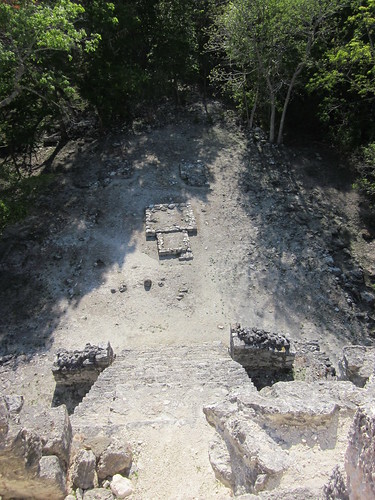
When I came down from the pyramid, I noticed a sign that said there was to be no climbing on the buildings. I think that’s a good rule but I’m kind of glad I didn’t read it until I’d already had my moment at the apex.
Nacho and Gerardo – my guide and driver – showed me around. After they noticed my obvious interest in all things Mayan, Mexican and food-related, they opened up.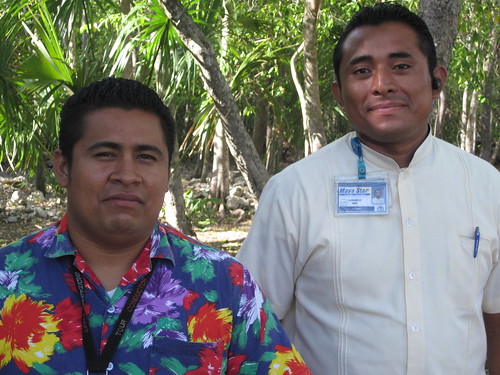
There is an undeniable sweetness about the Mexican character, a gentleness that was probably in the cultural DNA of indigenous peoples even during times when captives had their pumping hearts ripped out in sacrifice to a hungry sun.
Anyway, Nacho and Gerardo gave me a lot of information in our few hours together, much of which I’m still processing.
Driving home from the site, Nacho spotted a tamalyera and we stopped for a tamale.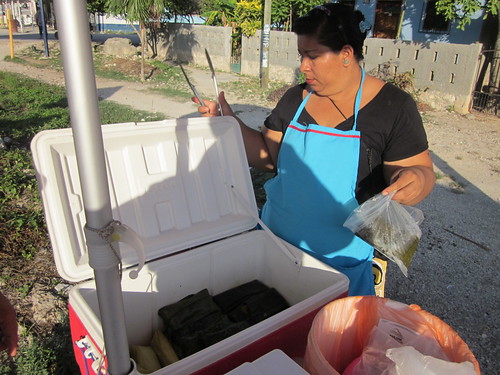
While we munched our snack, Nacho asked me if I'd ever eaten chaya, and I admitted I had not. He pointed out the chaya tree, growing in the intense heat, in the unforgiving ground, up against a building.
Turns out, chaya is a kind of miracle plant, with iron and other minerals in significantly greater percentages than, say, spinach. Yet few outside the Yucatan seem to have heard of it. They’ve been eating it in these parts for centuries.
After my visit to Muyil, I spotted chaya on a number of dishes I had over the past few days. It shows up frequently as a garnish (which should not be eaten raw, as there are cyanide-related toxins in there):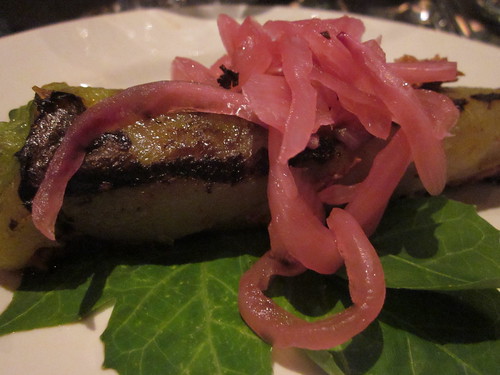
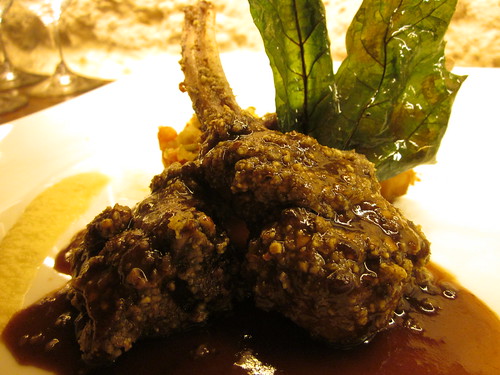
I’m pretty sure I’ve seen chaya at Hispanic groceries around Chicago (though I could be mistaken); next time I see it, I’m going to buy some and prepare it.
Nacho told me that when his grandmother used to make chaya, she followed the Mayan custom of singing to the vegetable as it cooked, so that it would turn out well (if it’s not cooked correctly, or perhaps long enough, it can make you sick). It’s possible that singing a song was a way for cooks to ensure that the chaya cooked enough (for instance, maybe the idea is that you have to cook it for the duration of the tune and not remove it from heat before the song, or song cycle, is over).
Hearing about grandmother cooks singing to their chaya makes me want to spend more time in Mayaland. Just as temples and other structures are being reclaimed from centuries of jungle overgrowth, there’s culinary knowledge and folkways yet to be uncovered, which I find very exciting."Don't you ever underestimate the power of a female." Bootsy Collins
-
-
-
Post #3 - June 20th, 2011, 3:32 pmI wonder if it's not that it is cyanide but excessive oxalates? They can really do you in if you eat too much of them raw.Leek
SAVING ONE DOG may not change the world,
but it CHANGES THE WORLD for that one dog.
American Brittany Rescue always needs foster homes. Please think about helping that one dog. http://www.americanbrittanyrescue.org
-
-
Post #4 - June 20th, 2011, 7:15 pmDavid Hammond wrote:The heat lies like a warm moist hand on the jungle, and it actually seems to put me in a semi-hallucinatory state, almost ecstatic, a little crazy from the heat.
Maybe it was the cyanide from the chaya. I'm kidding (I think) but read on.leek wrote:I wonder if it's not that it is cyanide but excessive oxalates?
No, raw chaya leaves contain cyanide (or more precisely, cyanogenic glycosides that can be cleaved to yield cyanide). That report says the aqua fresca is made with raw leaves. Same for this one:debi in mérida wrote:My preparation; after consulting with several 'locals' on how best to prepare and consume agua de chaya is to clean 5-6 medium/large chaya leaves, squeeze 4 medium limon indio (local limes), add honey to taste, I use about a tablespoon of local honey to 1 liter of water and blend till the leaves are pulverized.
I keep reading more and more about the potential harm from cyanide poising from consuming uncooked chaya. To date, neither Tom nor I have noticed any ill effects. I am however considering the 5 minute boil prior to blending the ingredients; but only becuase we are drinking our agua de chaya daily.
I think the acid in the citrus juice may be sufficient to break down the glycoside but, even if that's the case, you want to allow time for the hydrogen cyanide that's liberated to dissipate. Has anyone ever come across agua de chaya made without citrus?
Of course, it's also a matter of quantity. You'd have to eat a lot of raw chaya to even approach the lethal dose.
-
-
Post #5 - June 20th, 2011, 10:50 pmRene G wrote:Of course, it's also a matter of quantity. You'd have to eat a lot of raw chaya to even approach the lethal dose.
I lost all feeling below the waist. Could that be a problem?
I actually didn't "discover" chaya until late in the second day of my visit, and the trip to Muyil was the first thing I did upon landing Day One, so I don't think the feeling of exhileration was due to ingestion of toxins (at least from chaya).
I'm not sure if the agua fresca I enjoyed had citrus in it, but it very well could have. It had a very "fresh," uncooked taste, so I was surprised to hear that cooking the chaya was part of the recipe."Don't you ever underestimate the power of a female." Bootsy Collins
-
-
Post #6 - June 22nd, 2011, 3:35 pmDavid Hammond wrote:I lost all feeling below the waist. Could that be a problem?

Nah, perfectly normal . . . if you're afflicted with konzo, that is.
Very interesting post. I look forward to seeing and reading more about your trip.
-
-
Post #7 - June 24th, 2011, 7:07 pmAntonio Contreras of Xni-Pec told me today that his mother asks permission of the chaya plant before snipping its leaves.
This, apparently, is a plant that requires a lot of emotional maintenance."Don't you ever underestimate the power of a female." Bootsy Collins
-
-
Post #8 - February 13th, 2019, 9:28 amDavid Hammond wrote:The Maya and the Chaya
I was headed to Riviera Maya last week (the new name for the region on the east coast of the peninsula), and I posted about that trip. LTHer Krasmania works with Apple Vacations, read my post, and he set me up with a driver and guide to take me from Grand Velas, a resort near Playa del Carmen, to Muyil, a ride of about 80 minutes.
Hi David,
Mrs Willie & I are heading to the Andaz resort Riviera Maya on Friday. Burning some Hyatt points for the free stay. Is is possible to FW the driver info you mention above?
I'll also search for your other post about Riviera Maya.
Thank you,
WillieI did absolutely nothing and it was everything I thought it could be.
-
-
Post #9 - March 2nd, 2019, 5:06 pmWillie, so sorry, just saw this post (I didn't get an email message that you'd responded to the thread). I'm guessing the information would do you no good now, right?"Don't you ever underestimate the power of a female." Bootsy Collins

